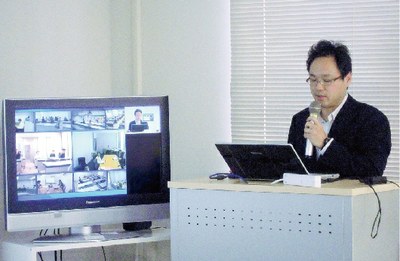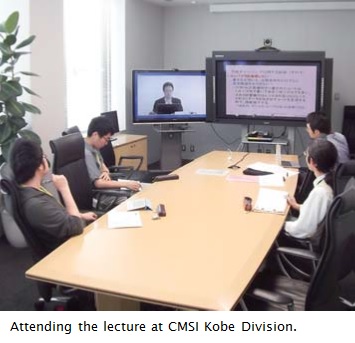CMSI Distance Learning
Masaaki Geshi
Project Associate Professor, Institute for NanoScience Design, Osaka University
 The CMSI Personnel Development Project started in earnest from this fiscal year. Osaka University is using a video conference system to deliver the course “Advanced Computational Science A” to ten locations including key universities functioning as the CMSI Education Divisions. These lectures are recorded, and published on the CMSI website. In fiscal 2014, the course “Advanced Computational Science B” is scheduled for release. Osaka University counts the credits towards graduate school. Until now, the development of researchers in computational science depended on individual laboratories scattered across the country, and in most cases, numeric calculation technologies have only been studied and learned to the extent required for the respective research according to need. However, the mainstream of computers is moving from vector computers to massively parallel types, and hardware configurations are also becoming more complex. Gaining the knowledge to program on them to exploit their performance is largely beyond the capability of a single laboratory or individual. In the past, people thought, “First let’s make it serially, and if we have problems with speed, we’ ll make it parallel.” But now, if it is clear from the start that the software being developed is large scale with long computing times, they realize that they should be starting development by creating parallel algorithms from the beginning. In other words, it is necessary to know about parallelization such as HPC from the start of development. Most of the globally renowned computational science software comes from America and Europe. In order to compete with this, instead of individual laboratories continuing to work on development, it is necessary to establish a common curriculum with the goal of training young staff across Japan as a whole.
The CMSI Personnel Development Project started in earnest from this fiscal year. Osaka University is using a video conference system to deliver the course “Advanced Computational Science A” to ten locations including key universities functioning as the CMSI Education Divisions. These lectures are recorded, and published on the CMSI website. In fiscal 2014, the course “Advanced Computational Science B” is scheduled for release. Osaka University counts the credits towards graduate school. Until now, the development of researchers in computational science depended on individual laboratories scattered across the country, and in most cases, numeric calculation technologies have only been studied and learned to the extent required for the respective research according to need. However, the mainstream of computers is moving from vector computers to massively parallel types, and hardware configurations are also becoming more complex. Gaining the knowledge to program on them to exploit their performance is largely beyond the capability of a single laboratory or individual. In the past, people thought, “First let’s make it serially, and if we have problems with speed, we’ ll make it parallel.” But now, if it is clear from the start that the software being developed is large scale with long computing times, they realize that they should be starting development by creating parallel algorithms from the beginning. In other words, it is necessary to know about parallelization such as HPC from the start of development. Most of the globally renowned computational science software comes from America and Europe. In order to compete with this, instead of individual laboratories continuing to work on development, it is necessary to establish a common curriculum with the goal of training young staff across Japan as a whole.
Since the personnel who need to be developed by CMSI are scattered around the country, it would be efficient to use teleconferencing to provide lectures simultaneously. In this way, even if the teaching staff are busy and cannot teach the students from zero, it will be possible to reduce their burden by distributing the minimum knowledge on the Web, with each teacher providing additional guidance in accordance with the themes of their respective laboratories.
The personnel required for the future of computational science can be broadly divided into two ̶ people who can develop software, and people who will use the software for research (users). The former will be essential to progress in computational science. In addition to scientific ability, they will need to have knowledge of numerical analysis and architecture, and the ability to collaborate with specialists in those fields. As for the latter, the number of experimentalists can be expected to increase further, with computational science increasingly being used as an experimental tool. In the curriculum for the former, the technologies and knowledge common to all fields will be provided as common subjects, with the technologies specific to the various technologies specific to the various techniques being provided as specialized subjects (Figure 1). For user training, lectures will be given outlining the basic theory of the respective techniques and various methods, with examples of applications (Figure 2).
The most important lectures will involve practical work, with hands-on training in actual use of the software. Curricula must be developed in this way to match the needs of developer training and user training, establishing a system for training the community as a whole. Personnel development has an inseparable relationship with making the hardware for a supercomputer. Today when planning for the next exaflops-class supercomputer after the K computer has started, we must now focus on training personnel who can make use of it as soon as it goes into operation. In addition, it is essential to obtain highly capable personnel and so another issue of the highest priority is undertaking public awareness among the generation who will be active in ten years’ time. These lectures are being conducted with know-how implemented by Osaka University in educating adults and graduate students for the last ten years, and this approach will become a model case for the future of graduate school education.

